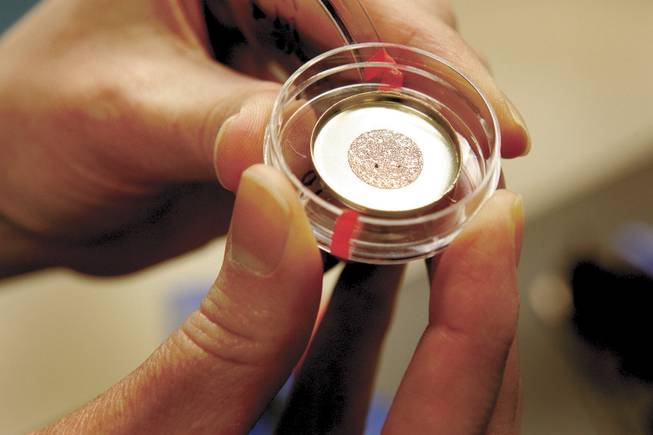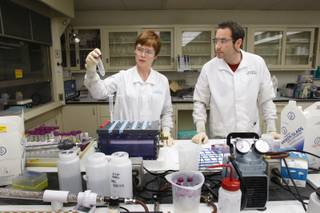
Julie Gostic, a radiochemistry graduate student, holds a radioactive sample (the black speck) at a UNLV lab Tuesday. Radiochemistry is the study of the chemical and physical properties of radioactive elements. Among the subjects of research in the program is various aspects of nuclear waste.
Monday, April 27, 2009 | 2 a.m.
Sun Archives
- Higher education system outlines 'doomsday' budget effects (3-25-2009)
- A setback for research (2-14-2009)
- Gov. Gibbons strikes back – with a podcast (2-11-2009)
- Rogers highlights ways universities have saved money (2-9-2009)
- As budget cuts loom, UNLV lacks requested program rankings (2-8-2009)
- Funding inequities have no simple fix (2-6-2009)
- UNLV must scramble to save $25 million gift, hotel building (2-2-2009)
- Administrators says proposed cuts too much to withstand (1-26-2009)
- Research park running through cash, still empty (1-25-2009)
Beyond the Sun
The multimillion-dollar cache of laboratory equipment is impressive enough to excite some of the country’s top scientists. The cutting-edge research could lead to better ways to combat cancer and improve national security.
UNLV’s radiochemistry program, though only 5 years old, is partnering with national lab researchers and drawing students from universities such as the Massachusetts Institute of Technology.
Administrators say this is the type of program they want to grow: research-intensive and sustainable with limited state funding. And radiochemistry, the study of the chemical and physical properties of radioactive elements, is particularly relevant in a region that is home to a 60-year-old nuclear test site, a proposed nuclear waste repository and a fledgling cancer research institute.
UNLV’s program, one of few in the nation, offers a doctoral degree and serves about 20 students who work with faculty to study topics including emergency response and how nuclear waste spreads.
As UNLV looks to launch itself into the ranks of top research universities, the radiochemistry program’s metamorphosis from no-name to nationally recognized is instructive.
It demonstrates that the caliber of founding faculty members can have a profound effect on the success and growth of top-shelf academic programs. And it hints that if UNLV is ever to undergo its own transformation into a research powerhouse, the university may need to offer budding superstars more support.
The story behind the rise of radiochemistry at UNLV begins in the 2002-03 academic year — in Cambridge, Mass., when MIT denied tenure to Ken Czerwinski, a chemist in its nuclear engineering department.
He knew he would have opportunities elsewhere. The MIT post was his first full-time professorship, but before taking that position in late 1996, he had spent several years in Europe studying topics including the way nuclear waste behaved in repositories.
He had completed his Ph.D. in nuclear chemistry at the University of California, Berkeley, in 1992. Glenn Seaborg, a Nobel Prize-winning Berkeley researcher who co-discovered elements including plutonium, was a co-author on Czerwinski’s first major publication.
According to Czerwinski, MIT wanted him to stay on as a nontenured faculty member, but he refused. “I was like, ‘You want to be friends? Is that it?’ I said no. I wanted to do the tenure-track professor thing.”
Czerwinski had connections at UNLV, which was launching a radiochemistry program. Tony Hechanova and Gary Cerefice, researchers there, were MIT alumni, and Cerefice had studied under Czerwinski.
Czerwinski had an offer from the University of Florida. But UNLV won out. Like many academics who take a chance on the young school, Czerwinski liked the idea of creating a program.
From the start, his goals were bold — the type that, in someone else’s hands, might have died as nothing more than grandiose dreams. What he wanted, he said, was to build “the best place at an American university to do radiochemistry.”
In 2003, Czerwinski got to work by tapping the network of professional contacts he had cultivated over the years. UNLV’s first radiochemistry students included Julie and Rich Gostic, a husband-and-wife team who knew Czerwinski from MIT, where Rich Gostic had earned a master’s in nuclear engineering.
“We knew it would be fun because it would be crazy,” Rich Gostic said of the decision to enroll at UNLV in 2005.
Julie Gostic called Czerwinski a “mover and shaker” and praised him for accepting students from fields ranging from chemistry to biology and engineering.
“Other programs (at other universities) do not think outside of the box like that,” she wrote in an e-mail. “They have the mind-set that you can never be a good radiochemist without having a strong chemistry background.”
A visit with Czerwinski sheds light on why the Gostics and others were willing to join a program that had no history, no track record. With immaculate posture, a strong, square jaw and brilliant blue eyes, the professor has charisma, a commanding presence.
The man is a human whirlwind. While sitting for interviews in his office, he checks e-mail, takes phone calls and chats with doctoral candidates who drop in with questions.
His love for teaching is evident. His office door is plastered with student work — graphs, charts, calculations — that would boggle the average person. He lists “radiochemical education of undergraduate and graduate students” as an area of interest on his curriculum vitae.
His activities outside UNLV include consulting for private companies and teaching at an Energy Department radiochemistry summer school.
Last year, he said, he didn’t have time to apply for promotion because he “just had so much other stuff to do.”
State support for the program has been limited, and Czerwinski has not been able to hire an administrative assistant to help with such tasks as processing student applications — not a trivial issue, he said, “because I’m getting exhausted.”
His fatigue, though partly a product of his own tall ambitions, is also a symptom of what many faculty members consider a problem at UNLV: a lack of adequate support in building programs and conducting research.
Czerwinski said although higher-ups such as the dean of sciences have shown enthusiasm for radiochemistry, he wonders how his program corresponds with UNLV’s goals: “Somehow, I still don’t know how what I’m doing here fits into what the university wants to become.”
“By a number of metrics, I can say, ‘Yeah. I think we’re succeeding,’ ” he said. “But if the administration doesn’t know how to place us or if we don’t fit into the vision of what’s here, then how logical is it to have it here?”
Figuring out which administrators to contact about the program’s needs can be difficult, Czerwinski said. Radiochemistry was established by the chemistry and health physics departments, which are housed in different colleges within the university, he said. Czerwinski’s office and much of the program’s lab space are in the Harry Reid Center, separate from both departments.
In a $113 million science and engineering building the university is opening this year, half of the work space in the core laboratory reserved for radiochemistry is not equipped to handle high-level radioactive materials.
The placement of radiochemistry work stations in the same room as work stations for other disciplines makes it more difficult to ensure safety and prevent radioactive contamination of areas where researchers are not using radioactive materials.
Help from outside the university has been crucial to the radiochemistry program’s success.
Since coming to UNLV, Czerwinski has been named a principal investigator on projects that should bring in more than $6 million from external agencies such as the Energy Department. Ralf Sudowe, a radiochemistry faculty member who joined UNLV in 2006, has pulled in more than $1.5 million in outside funding, primarily federal earmarks.
This money, along with additional earmarks, has helped the radiochemistry program acquire the high-tech tools it needed, all purchased since Czerwinski arrived.
The collection caught the eye of Al Sattelberger, now associate laboratory director for energy sciences and engineering at Argonne National Laboratory, one of the Energy Department’s oldest and largest science and engineering research labs.
Sattelberger joined the UNLV program as a visiting scientist a few years ago, drawn by the university’s equipment and by Czerwinski, whom Sattelberger had interviewed years before for a job at another national lab.
External funding also covers stipends for doctoral students conducting research. They get $22,500 in their first year, with raises later. The program also pays for tuition, fees and health care. Such compensation would be impossible if the program relied, as many others do, on state money.
Together, students and faculty research a wide range of subjects. They are studying the chemical properties, such as the physical structure, of a compound of technetium, an element used in some cancer radiation treatments.
The Gostics are analyzing soil from a New Jersey Air Force base where a nuclear warhead was destroyed in a fire in 1960. Their research will provide insight into the behavior of nuclear waste — how it travels, for instance, when it comes into contact with water.
Sudowe, formerly a Lawrence Berkeley National Laboratory scientist, is exploring ways labs could analyze debris samples from nuclear accident or attack sites more quickly to determine how widely radioactive material has spread and where the material might have originated.
Such research has helped the program gain prestige. At conferences, Julie Gostic said, fellow attendees say, “Oh, you’re at UNLV. Wow.”
And although Czerwinski is uncertain about how his program fits into UNLV’s goals, some of his colleagues have a clear understanding. Sudowe, for one, says radiochemistry is “a good example of where the university wants to go.”
Executive Vice President and Provost Neal Smatresk called the program “a nexus of quality that we should build around.”
When UNLV emerges from “this fiscal mess,” he said in an e-mail, the university will prioritize hiring in “strategic areas like rad chem.”


Join the Discussion:
Check this out for a full explanation of our conversion to the LiveFyre commenting system and instructions on how to sign up for an account.
Full comments policy